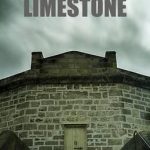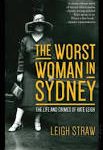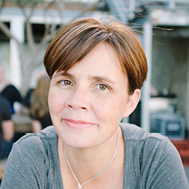Sisters in Crime national co-convenor, Robyn Walton, spoke to WA author Leigh Straw about two of her recent books: Limestone (Kennedy and Boyd, Edinburgh, 2015) and The Worst Woman in Sydney: The Life and Crimes of Kate Leigh (NewSouth, Sydney, 2016)
Hello Leigh. Shall we start by talking about your debut crime fiction novel, Limestone? Then I’ll ask you about your most recent non-fiction crime title, The Worst Woman in Sydney.
Am I right in saying Limestone is the first in a projected three-novel series set in contemporary Western Australia and featuring your police detective protagonist Claire Patterson?
Yes, Limestone is the first of three books featuring fictional Fremantle police detective Claire Patterson. The second, The Call, was released in 2016.
Claire and her colleagues fear a serial killer of women is active. A few Australian writers and film makers have paid attention to the real-life 1986 Moorhouse Murders carried out by David and Catherine Birnie. And in December 2016 a man was charged in relation to the Claremont deaths and disappearances of young women in 1996-97. Did historic cases influence your novel?
Historic cases had some influence on the novel because they are still a part of our social fabric. So, if you’re going to place a detective on a serial killer case, readers will draw a connection with the Claremont case and other serial killer cases. What I didn’t want to do, however, was to turn the story entirely into historical crime fiction, so I have played around with some details and fictionalised some stories.
 Why the Fremantle setting for Limestone? And why have your police called their investigation Operation Limestone?
Why the Fremantle setting for Limestone? And why have your police called their investigation Operation Limestone?
Fremantle is a great setting for crime fiction. It is a port city that has an interesting working-class history and it still has a number of old buildings and alleyways that can be historic or sinister, depending on the time of day and how you imagine crimes being committed and crime scenes being set up. It has always made me think of parts of cities in Scotland and, with the port, it is reminiscent of Leith or Glasgow in Scotland.
Freo offers pubs, eateries and entertainment venues, with some of these figuring in your characters’ professional and personal lives. Any comments?
As I also work in Fremantle, I see on a daily basis how people work, live and connect with the Freo social scene. It makes sense that the police officers would take advantage of the city’s social scene after their shifts. Readers will find mention of some of my favourite places such as Bar Orient and what used to be Rosie O’Grady’s but is now the Federal Hotel. The wonderful bar Strange Company will also feature in the third book. The places are less to do at times with restaurants and entertainment venues and more to do with pubs as I have created police officers who prefer pubs and like a drink.
To what extent did you care about having your officers conform with standard policing procedures?
The value of fiction is you don’t always have to get things entirely right. You can base a police station, for example, on a real one but not have it exactly the same. However, where possible I did run crime scene ideas and investigation details past current serving officers so that the policing procedures detailed were plausible.
Claire used to be in a relationship with her fellow detective Michael Halliday, and her current partner is a journalist. Personal-professional complications enrich the story?
I think this always makes things interesting and can enrich the investigations. Michael is obviously furious that Claire would take up with a journalist because he sees the media as using crime stories for public or entertainment gain. The relationship between Claire and Michael is the common one some people face in having to work with someone you used to be in a serious relationship with. What is does on the Limestone case is challenge Claire and Michael to put their personal grievances aside to find the murderer or murderers.
What are Claire’s best qualities? Do you imagine her changing much in the coming novels?
I deliberately made Claire confused and lacking in confidence at times in the first novel. This way the reader gets to know someone who seems realistic and isn’t some super-cop. It also shows us what she is up against. She second-guesses herself because she is still in a male-dominated policing world. Characters should develop and change in stories and we see that with Claire, especially in the second novel.
***
Now let’s look at The Worst Woman in Sydney.
 When career criminal Kate Leigh and her rival, Tilly Devine, were at the height of their influence in Sydney in the 1920s-40s they were celebrities. Your thoughts on this phenomenon?
When career criminal Kate Leigh and her rival, Tilly Devine, were at the height of their influence in Sydney in the 1920s-40s they were celebrities. Your thoughts on this phenomenon?
It was this aspect of Kate Leigh’s that really drew me into her story. I’ve researched a number of different criminal women through the years but Kate stood out as I found myself fascinated by how she was able to manipulate her public image and turn herself into a celebrity. In the first instance, Kate and Tilly became criminal-celebrities because of the sheer scale of the crimes they were involved in. They were at the centre of the rise of organised crime in Sydney so the newspapers jumped on the opportunity to tell sensational (and often true) stories about their appearances in court and latest criminal antics. This grabbed the attention of the public and they started following the criminal careers of Leigh and Devine through the newspapers. More than this though, their celebrity was based on careful manipulation from the two women. They talked to their favourite reporters and made sure the photographs taken of them for the papers were how they wanted to be seen. They controlled their image in a variety of ways but still suffered from the sexism in the reports which sexualised their identities and demeaned them through use of stereotypical language and imagery. But they at least tried to have a hand in their own celebrity status.
Actor Danielle Cormack played Kate in the 2011 television program Underbelly: Razor, based on Larry Writer’s 2001 true-crime book Razor: Tilly Devine, Kate Leigh and the Razor Gangs. What did you think of this characterisation of Kate?
I think Danielle Cormack’s portrayal of Kate was very good and it was obvious she had researched Kate’s life closely to inform her performance. Danielle captured the contradictions in Kate’s life and her tough and confident approach to running underworld businesses. I didn’t entirely agree with the sexualisation of Kate Leigh in the television program but Underbelly is a brand and has particular ways of telling stories. It was never going to be entirely faithful to the book it was based on because of the reputation it had already created in telling criminal stories (and had found success in doing so with Australian audiences). I do think, however, that Danielle’s portrayal was greatly assisted by Larry’s wonderful book and his production consultations.
Crime writer Tara Moss has argued that the femme fatale archetype has obscured our recognition of real-life female outlaws who are/were proactive and interesting. Any comments?
I agree with Tara Moss. For too long, popular culture has focussed on the femme fatale archetype to the detriment of understanding the greater complexities around female criminals. In the past, crime history either overlooked women or portrayed them as vulnerable or victims. There was little recognition for female outlaws. In a nation obsessed with the likes of Ned Kelly, we need to re-think our outlaws and look for the women who were proactive and interesting. Kate Leigh is one of them.
Kate’s main income stream came from ‘sly grog’. What does this tell us about Australia’s social history? And were there parallels to America’s experience of the Prohibition era?
Kate’s income from sly grog was made on the back on temperance campaigns from the middle of the nineteenth century looking to prohibit the sale and consumption of alcohol. Their campaigns, grounded in religious temperance ideals, were based on raising awareness about the impact of excessive drinking on women and families, especially in relation to violence in the home. Australia came very close to full Prohibition but opted instead for the early closing of pubs – 6pm in the eastern states, except for Queensland where it was 8pm from 1923 and 9pm in Western Australia. Like the Prohibition Era in the United States, alcohol restrictions led to an increase in underworld activities. In the US it was bootlegging and over here it was sly grog selling (illicitly selling alcohol after the pubs were closed and from unlicensed premises like houses and shops).
Kate also kept brothels and dealt in cocaine. “As an intelligent businesswoman … she knew there was a fortune to be made from combining sly grog with sex and drugs.” (p. 109). Your observations?
Kate Leigh was a criminal entrepreneur. I don’t think we’ve investigated this enough when looking at women and crime, especially in the early twentieth century. Leigh knew organised crime could only continue to flourish with corruption so she made sure she played the system well and by that I mean knowing the police officers and politicians to go to.
Violence and standover tactics were required to defend Kate’s empire. And gangs of young men had been active in inner Sydney since the 1880s. Where did Kate stand in relation to violence and gangs?
Kate Leigh had lived and learned from life in eastern Sydney. In order to establish herself as an underworld leader, she had to protect her business and this meant using violence and her associates to do this. It was, as Larry Writer has said, the law of the razor back in those days.
Kate (‘Mum’) became a crime matriarch figure in the inner eastern suburb of Surry Hills. Her daughter Eileen became a criminal too. Your thoughts on inter-generational organised crime?
What sometimes happens is that crime in a family becomes normalised. When you have been around it from a young age, it is simply a normal way in which your family functions. This is essentially what happened with Eileen Leigh. I think some of it also had to do with character traits that were passed on, as Eileen shared a great deal of her mother’s toughness and resilience.
Lillian Armfield, who joined the NSW Women’s Police in 1915, had encounters with Kate. I understand you’re now writing a book about Lillian’s pioneering career in policing?
Lillian Armfield has always fascinated me because she is the other side of Kate’s story. Lillian was given the task from 1915, as one of two of the first female police officers in Australia, to police young girls and women involved in crime or threatened by it. This brought her into direct contact with Kate Leigh. Like Kate, Lillian was a tough, resilient, smart woman from country NSW who made a name for herself in a man’s world: fighting crime as a police officer.
After sharing Kate Leigh’s story, I knew I had to tell Lillian’s and I’ve found that her story is just as fascinating as Kate’s. Lillian Armfield’s ability to serve in the police for over thirty years and strike a blow to gender inequalities is an inspirational, unique Australian story.
Looking back over your Kate Leigh book and your Claire Patterson novel, do you see overlap in your choice of content, your narrative methods, or anything else?
I certainly enjoy telling stories that feature women and are driven by a purpose to ensure that female voices shout out from the pages of fiction and non-fiction. I like stories that empower women through looking at us as complex and deeply engaging people. I’m certainly interested in crime stories – real and fictionalised — and the darker side of life.
Leigh, thanks for your answers and all the best for your future projects.
Catch up with Leigh Straw (and Sarah Bailey and Dorothy Johnston) at Sisters in Crime’s Melbourne’ event on Friday 21 July – Sea Change or Tree Change?: crime (fiction) moves to the coast and country. Click here for info and bookings.
Click here for Robyn Walton’s review of Limestone.
